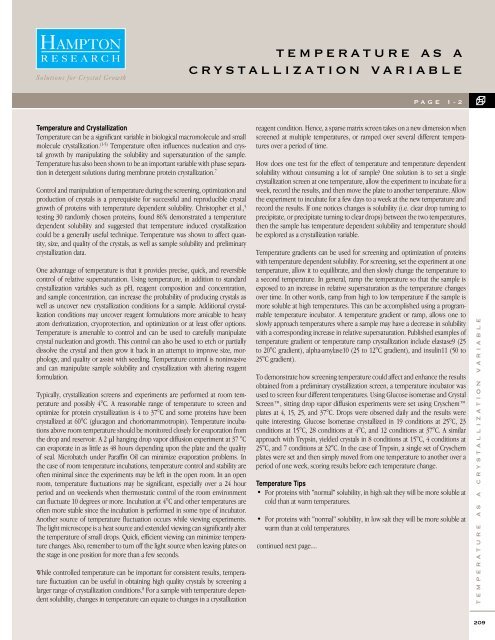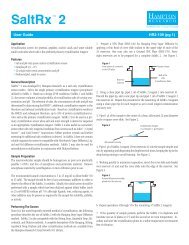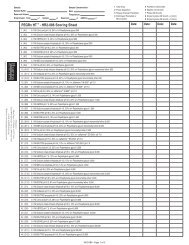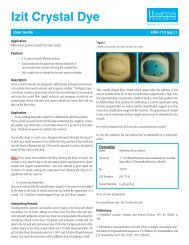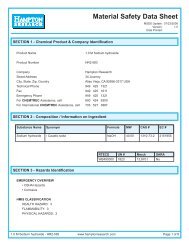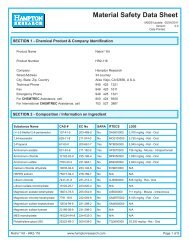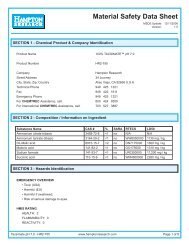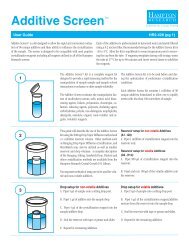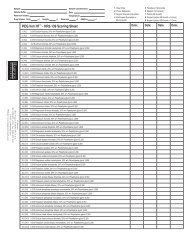Download - Hampton Research
Download - Hampton Research
Download - Hampton Research
Create successful ePaper yourself
Turn your PDF publications into a flip-book with our unique Google optimized e-Paper software.
Solutions for Crystal Growth<br />
temperature as a<br />
crystallization variable<br />
Page 1-2<br />
Temperature and Crystallization<br />
Temperature can be a significant variable in biological macromolecule and small<br />
molecule crystallization. (1-5) Temperature often influences nucleation and crystal<br />
growth by manipulating the solubility and supersaturation of the sample.<br />
Temperature has also been shown to be an important variable with phase separation<br />
in detergent solutions during membrane protein crystallization. 7<br />
Control and manipulation of temperature during the screening, optimization and<br />
production of crystals is a prerequisite for successful and reproducible crystal<br />
growth of proteins with temperature dependent solubility. Christopher et al., 5<br />
testing 30 randomly chosen proteins, found 86% demonstrated a temperature<br />
dependent solubility and suggested that temperature induced crystallization<br />
could be a generally useful technique. Temperature was shown to affect quantity,<br />
size, and quality of the crystals, as well as sample solubility and preliminary<br />
crystallization data.<br />
One advantage of temperature is that it provides precise, quick, and reversible<br />
control of relative supersaturation. Using temperature, in addition to standard<br />
crystallization variables such as pH, reagent composition and concentration,<br />
and sample concentration, can increase the probability of producing crystals as<br />
well as uncover new crystallization conditions for a sample. Additional crystallization<br />
conditions may uncover reagent formulations more amicable to heavy<br />
atom derivatization, cryoprotection, and optimization or at least offer options.<br />
Temperature is amenable to control and can be used to carefully manipulate<br />
crystal nucleation and growth. This control can also be used to etch or partially<br />
dissolve the crystal and then grow it back in an attempt to improve size, morphology,<br />
and quality or assist with seeding. Temperature control is noninvasive<br />
and can manipulate sample solubility and crystallization with altering reagent<br />
formulation.<br />
Typically, crystallization screens and experiments are performed at room temperature<br />
and possibly 4°C. A reasonable range of temperature to screen and<br />
optimize for protein crystallization is 4 to 37°C and some proteins have been<br />
crystallized at 60°C (glucagon and choriomammotropin). Temperature incubations<br />
above room temperature should be monitored closely for evaporation from<br />
the drop and reservoir. A 2 µl hanging drop vapor diffusion experiment at 37 °C<br />
can evaporate in as little as 48 hours depending upon the plate and the quality<br />
of seal. Microbatch under Paraffin Oil can minimize evaporation problems. In<br />
the case of room temperature incubations, temperature control and stability are<br />
often minimal since the experiments may be left in the open room. In an open<br />
room, temperature fluctuations may be significant, especially over a 24 hour<br />
period and on weekends when thermostatic control of the room environment<br />
can fluctuate 10 degrees or more. Incubation at 4°C and other temperatures are<br />
often more stable since the incubation is performed in some type of incubator.<br />
Another source of temperature fluctuation occurs while viewing experiments.<br />
The light microscope is a heat source and extended viewing can significantly alter<br />
the temperature of small drops. Quick, efficient viewing can minimize temperature<br />
changes. Also, remember to turn off the light source when leaving plates on<br />
the stage in one position for more than a few seconds.<br />
While controlled temperature can be important for consistent results, temperature<br />
fluctuation can be useful in obtaining high quality crystals by screening a<br />
larger range of crystallization conditions. 8 For a sample with temperature dependent<br />
solubility, changes in temperature can equate to changes in a crystallization<br />
reagent condition. Hence, a sparse matrix screen takes on a new dimension when<br />
screened at multiple temperatures, or ramped over several different temperatures<br />
over a period of time.<br />
How does one test for the effect of temperature and temperature dependent<br />
solubility without consuming a lot of sample? One solution is to set a single<br />
crystallization screen at one temperature, allow the experiment to incubate for a<br />
week, record the results, and then move the plate to another temperature. Allow<br />
the experiment to incubate for a few days to a week at the new temperature and<br />
record the results. If one notices changes is solubility (i.e. clear drop turning to<br />
precipitate, or precipitate turning to clear drops) between the two temperatures,<br />
then the sample has temperature dependent solubility and temperature should<br />
be explored as a crystallization variable.<br />
Temperature gradients can be used for screening and optimization of proteins<br />
with temperature dependent solubility. For screening, set the experiment at one<br />
temperature, allow it to equilibrate, and then slowly change the temperature to<br />
a second temperature. In general, ramp the temperature so that the sample is<br />
exposed to an increase in relative supersaturation as the temperature changes<br />
over time. In other words, ramp from high to low temperature if the sample is<br />
more soluble at high temperatures. This can be accomplished using a programmable<br />
temperature incubator. A temperature gradient or ramp, allows one to<br />
slowly approach temperatures where a sample may have a decrease in solubility<br />
with a corresponding increase in relative supersaturation. Published examples of<br />
temperature gradient or temperature ramp crystallization include elastase9 (25<br />
to 20°C gradient), alpha-amylase10 (25 to 12°C gradient), and insulin11 (50 to<br />
25°C gradient).<br />
To demonstrate how screening temperature could affect and enhance the results<br />
obtained from a preliminary crystallization screen, a temperature incubator was<br />
used to screen four different temperatures. Using Glucose isomerase and Crystal<br />
Screen, sitting drop vapor diffusion experiments were set using Cryschem<br />
plates at 4, 15, 25, and 37°C. Drops were observed daily and the results were<br />
quite interesting. Glucose Isomerase crystallized in 19 conditions at 25°C, 23<br />
conditions at 15°C, 28 conditions at 4°C, and 12 conditions at 37°C. A similar<br />
approach with Trypsin, yielded crystals in 8 conditions at 15°C, 4 conditions at<br />
25°C, and 7 conditions at 32°C. In the case of Trypsin, a single set of Cryschem<br />
plates were set and then simply moved from one temperature to another over a<br />
period of one week, scoring results before each temperature change.<br />
Temperature Tips<br />
• For proteins with "normal" solubility, in high salt they will be more soluble at<br />
cold than at warm temperatures.<br />
• For proteins with "normal" solubility, in low salt they will be more soluble at<br />
warm than at cold temperatures.<br />
continued next page....<br />
temperature as a crystallization variable<br />
209


